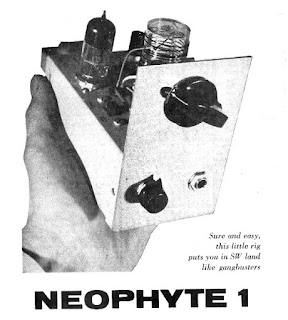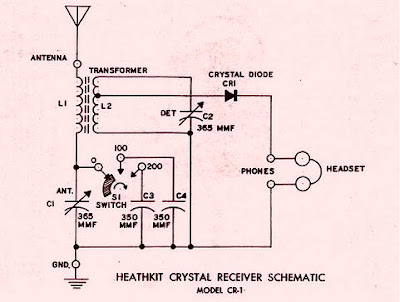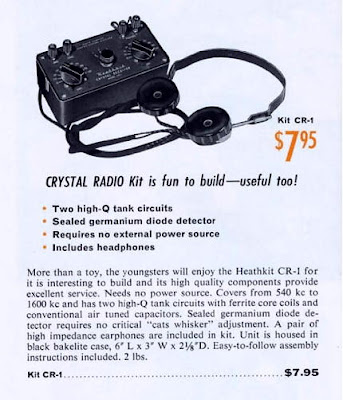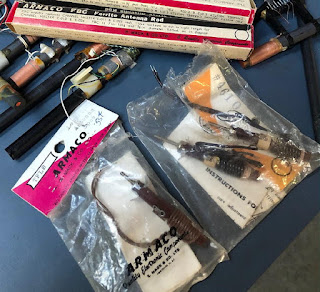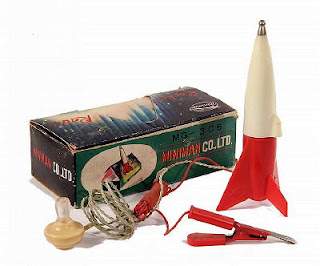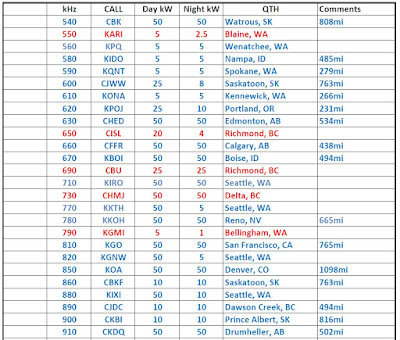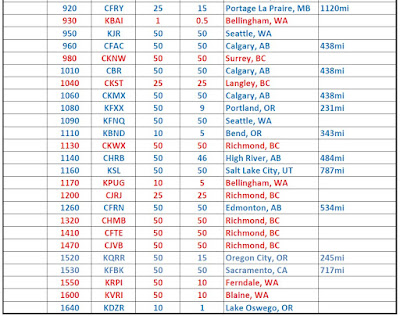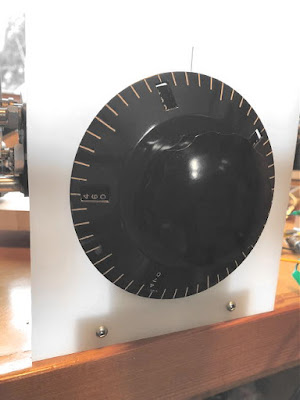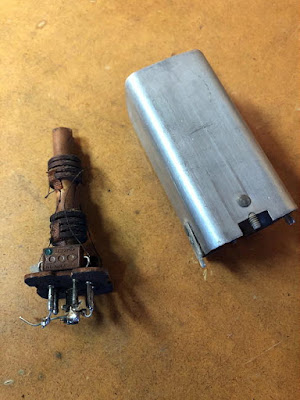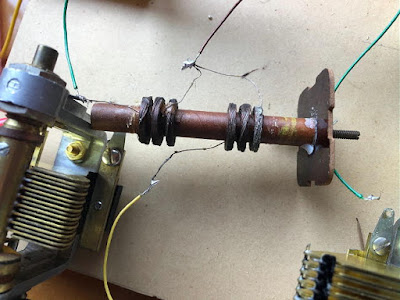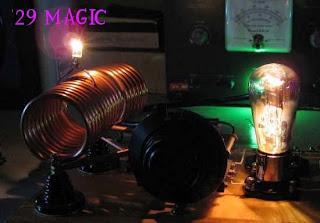Posts Tagged ‘homebrew’
 First Bug Contact!
First Bug Contact!
I never thought I’d be able to learn how to use a CW bug, but I did it. My XYL got me a Begali Intrepid for Christmas. I have been practicing with it for a few weeks and I finally got the gumption to attempt a contact. This evening I worked the SKCC station K3Y/4 operated by AB4PP in NC. I used a homebrew crystal-controlled transmitter (pictured on the left) putting out about 3 watts and a 40 meter regen receiver (right). I also have a homebrew SWR meter (upper left). The transmitter features a meter showing relative output power and the receiver which is varactor tuned has a frequency-indicating meter on the lower left. One of these days I’m going to put a frequency scale on the meter face. All the receiver controls are close together as you’re always adjusting everything on a regen and wished you had four hands to do it. Spotting of the transmit frequency is done with a blue push switch on the back part of the transmitter board which activates just the oscillator at a very low voltage as to not overload the regen receiver. The transmitter mutes the receiver front end on transmit and also injects sidetone into the receiver audio amp via the purple and blue wires. The entire setup is built with discrete components and is powered with a 12 volt lead acid battery on the upper left.
I think my code sounded pretty good, but undoubtedly I held a few dahs too long in all the excitement. This is radio fun, folks.

 NEOPHYTE Adventures
NEOPHYTE Adventures
I've just added a new page to my website, The VE7SL Radio Notebook, that describes my NEOPHYTE 1 regenerative receiver spring construction project. The new page can be found here.
Like most simple regens, its performance far exceeds its simple circuit expectations. My listening adventures with it continue during The Radio Board's annual Homebrew DX Contest which runs from July 11 - 24th. You may want to give it a try, after of course, you've checked-out my new web page!
 Barn Door Wide! Hunting For NDBs In CLE253
Barn Door Wide! Hunting For NDBs In CLE253

This weekend's upcoming CLE event will be the "Barn Door" listening event.
Participants are required to use receivers without the usual narrow filters. Some of the older tube radios can do this easily as can most homebrew receivers ... especially the regens!
If you've never listened to the NDB band with a wide bandwidth, it is a fascinating experience! If conditions are normal, you can typically hear a half dozen or more signals, all at various pitches, vying for your attention. It's almost as if you have plunked yourself down in the middle of the NDB forest of signals, and they are coming at you from all directions.
Many choose to use one of their homebrew receivers for this event, often as simple as a '1AD' or a '1 Active Device' circuit.
From organizer Brian Keyte:
Times: Start at Midday on Friday 21st, your LOCAL time
End at Midday on Monday 24th, your LOCAL time
Frequencies: Centred on 360 kHz (see below)
NDBs: NOT MORE than 100 'normal' NDBs including any UNIDs
(That is not intended to be a target to reach)
Whichever you choose, use the same receiver throughout the CLE.
**************************
These listening events serve several purposes. They:
- determine, worldwide, which beacons are actually in service and on-the-air so the online database can be kept up-to-date
- determine, worldwide, which beacons are out-of-service or have gone silent since the last CLE covering this range
- will indicate the state of propagation conditions at the various participant locations
- will give you an indication of how well your LF/MF receiving system is working
- give participants a fun yet challenging activity to keep their listening skills honed
The NDB List Group is a great place to learn more about the 'Art of NDB DXing' or to meet other listeners in your region. There is a lot of good information available there and new members are always very welcome. As well, you can follow the results of other CLE participants from night to night as propagation is always an active topic of discussion.
You need not be an NDB List member to participate in the CLEs and all reports, no matter how small, are of much value to the organizers.
Remember - 'First-time' logs are always VERY welcome!
Reports may be sent to the NDB List Group or e-mailed to CLE co-ordinator, Brian Keyte (G3SIA), whose address appears above. If you are a member of the group, all final results will also be e-mailed and posted there.
Please ... give the CLE a try ... then let us know what NDB's can be heard from your location! Your report can then be added to the worldwide database to help keep it up-to-date.
Have fun and good hunting!
 Loopstick Magic And The CR-1 Clone
Loopstick Magic And The CR-1 Clone
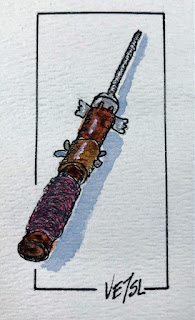 |
| BCB Ferrite Loopstick |
Regular blog readers may recall my two previous blogs, on the Heathkit CR-1 crystal radio receiver.
This very much sought-after radio is a well engineered ‘double-tuned’ set utilizing a series-tuned antenna tank circuit coupled to a parallel-tuned detector tank.
Both coils are wound on the same 1/4” diameter tubular form containing two ferrite slugs ... one for the antenna coil and one for the detector coil. The coils have been pre-wound and fixed on the form, about 20mm apart while the slugs have been waxed in place to set each inductance to the desired value.
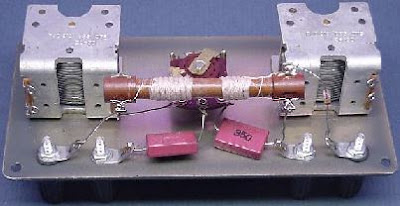 |
| courtesy: Scott's Crystal Radios |
I do wish that I'd had enough sense when I was a kid to buy myself a CR-1 as it seemed like they were dirt-cheap.
The $7.95 even included a set of headphones! Of course, $7.95 to a 12 year old was probably a lot of money, being about $70 in today’s currency!
My previous experience with homebrew DX crystal radios (ones that can hear stations other than strong locals) had taught me that they required large coils and ‘hot’ diodes. The CR-1 has neither of these yet it performed exceptionally well during the few weeks of evening tests a few months ago. I was able to log 50 stations, as described in the earlier blog ... and began to see that, just maybe, requirements may not be as rigid as I had always thought, when it comes to building DX sets!
When I discovered several ‘new-in-the bag’ broadcast band ferrite loopsticks in my junk box, I realized there might be an opportunity to allow me to make something very similar to the CR-1 circuit.
These are the same loopsticks used in the crystal ‘Rocket Radio’ of the 50s or in various transistor radios of the day.
I breadboard-mounted the two loopsticks so that the distance between the antenna coil and the detector coil could be adjusted, allowing some control over coupling and selectivity ... something not available with the stationary CR-1 coils.
Using the same antenna, headphones and external wavetraps, proved once again the excellent performance available from a very small and simple hi-Q coil system ... a DX machine without huge coils and expensive Litz! A total of 51 stations were logged over a two-week period, one more than was heard with the CR-1 and with a few ‘almost’ heards still waiting for one of those really good propagation nights. Having the ability to adjust the coupling was very helpful and made some of the weaker stations a little easier to detect. Stations in RED are local strong signals while those in BLUE are skywave propagated DX signals:
Mounting one of my old HRO 'PN' vernier dials on the main tuning capacitor provided plenty of bandspread, with each dial division corresponding to ~ 2kHz. It was very easy to locate any given frequency within the broadcast band once the dial was calibrated.
Soon after, I ran across a post by Zoltan Pap on Facebook’s ‘Crystal Set Radio Group’, describing his unique use of an old 455kHz I.F. transformer in a crystal tuner. I thought this was a rather brilliant idea and dug out an old I.F. can from the junkbox to see what it might offer.
The old I.F. can had two litz-wound (10 strand) tank coils, fixed in place over two adjustable ferrite slug cores ... in reality, something very similar to the, now very difficult to find, ferrite loopsticks used above.
The two inductors measured out at ~ 700uH - 1.1mH as the slugs were tuned from one end to the other. I was aiming for something close to the inductance used in the two CR-1 tank coils ... approximately 380uH.
A sufficient number of turns were removed from both coils to yield the needed inductance and both coils on the CR-1 breadboard clone were replaced with the old I.F. can coils.
In just a few minutes of tuning through the band, it was very easy to hear and separate all 16 local stations (RED in the above log). A few hours after sunset (on a not-so-good night) yielded quick copy of KPOJ (620kHz) in Portland, Oregon (231 miles) as well as CHED (630kHz) in Edmonton, Alberta (534 miles), demonstrating that even this old 1940's I.F. can could be turned into a crystal radio DX machine!
I don't believe the 'Q' of this pair of coils is very high, compared with the smaller loopstick, as its selectivity appears to drop off above 1000kHz. I'll try separating the form into two halves so that the coupling can be adjusted. The experiment is still under way but if you want to play and can't lay your hands on the pricey loopsticks, old I.F. cans are often much easier to find and probably a lot cheaper.
 ‘Barn Door’ CLE
‘Barn Door’ CLE
 The next CLE, coming up at the end of the month, will be another ‘barn-door’ event where listeners are encouraged to use wider bandwidths than normal ... typically something that will allow you to hear beacons at least 2kHz each side of the frequency that you are tuned to.
The next CLE, coming up at the end of the month, will be another ‘barn-door’ event where listeners are encouraged to use wider bandwidths than normal ... typically something that will allow you to hear beacons at least 2kHz each side of the frequency that you are tuned to.Your ears will be the only filter that you need!
This will be the first winter event of this type and results could be very interesting! In the past, many participants have used their homebrew regens including the popular ‘1AD’ (1 Active Device) MOSFET regen, built for the NDB part of the spectrum.
The last time this event occurred, I whipped together a 1AD regen in a day which proved amazingly effective in spite of the mid-summer propagation.
There is still plenty of time for you to put something simple together and you can find some helpful suggestions in my previous '1AD' blog here.
I will have more details later, before the event, so please stay tuned and consider getting something ready ... maybe all you need to do is wind a new coil for your favorite regenerative receiver!
 Here Comes The ’29 QSO Party!
Here Comes The ’29 QSO Party!
Saturday, November 9th, as well as the following Saturday (16th), will see the annual running of the Bruce Kelley 1929 QSO Party, otherwise known as the '1929 BK'.
Only transmitters that are 'era-appropriate' are allowed to be used. More specifically, transmitters must employ tubes that were available in 1929 or earlier, and transmitters must be self-excited. No crystals allowed! Crystals were new and largely unaffordable for most hams back in the depression days.
The year of 1929 marked a real turning point in amateur radio as governments finally cracked-down on things such as frequency stability, out of band operations and re-alignment of call districts. In short, hams were henceforth required to behave themselves and to clean up their signals and methods of operation.
 |
| courtesy: http://www.arrl.org/ |
If you tune across the CW bands during these two upcoming Saturday nights, you will have the rare opportunity to hear exactly what the bands would have sounded like back in the very early '30s'.
For the most part you will hear single-tube Hartley, Colpitts or TNT oscillators along with a few two-tube MOPAs thrown in. Many of them will suffer the same problems encountered by the boys of '29 ... chirp, drift, buzzy notes and frequency instability from antennas swaying in the wind.
The MOPAs will sound much better but some surprisingly nice-sounding signals can be heard coming from properly tuned and optimised single-tube oscillators. I recall being blown away by the lovely sounding signal I heard from such a rig when first tuning into the BK activity several years ago, only to learn that it was a self-excited Hartley using 1/4" copper tubing for the oscillator tank circuit!
The '29 watering-hole on 80m will be around 3550-3580 kilocycles (be careful not to confuse this with kilohertz!) while the early afternoon to post-sunset 40m activity will be found from 7100-7125 kc. There may even be a few on the very low end of 160m. Although many of these transmitter styles were used on 20m and higher, the BK rule-makers have wisely decided not to inflict these sounds on the present ham populace as it would likely keep the 'Official Observers' busy for several days writing pink-slips.
Like last year, I will set up my Hull Hartley (160, 80, 40m), as I haven't used it much since building the MOPA a few years ago. If it's very windy (almost assured), the Hartley will really sound like 1929!
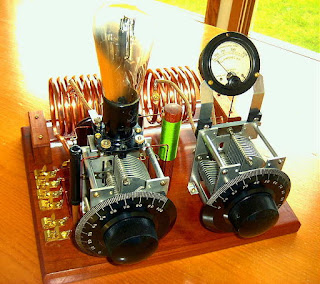 |
| My Hull Hartley |
You can learn more about amateur radio happenings leading up to and following the 1929 crackdown in my earlier series of 'Why '29' blogs here:
Part 2
Part 3
Part 4
Those wishing to put something together for next year's event can find everything needed here:
Building '29-Style - Part 1
Building '29-Style - Part 2
Let's hope for good conditions for this event as the last few years have been adversely affected by geomagnetic storming. Poor propagation or not, I guarantee there will be plenty of '29ers busy calling 'CQ AWA' on the low bands.
Complete BK details are available here.
 Building A ’37-Style ‘RK-39’ Crystal Power Oscillator
Building A ’37-Style ‘RK-39’ Crystal Power Oscillator

When I completed my ‘Jones 6L6 Push-Pull Oscillator’ project in the spring, I made a start on a new ‘spring-summer radio project’ which was to be based on some 1937 RK-39 tubes that had been gathering dust here for many years.
With an unusually sunny and warm spring, I soon found that my radio-bench time was being hi-jacked with a lot of outside yard work and getting all of next winter’s firewood split and stacked away before the really hot weather arrived.
I found myself working on the project in tiny bites, sometimes not making any progress at all during the passage of a week. Headway was also tempered by the fact that I’ll often deliberate for several days over the placement of a single component or the selection of one component over another. I find this slow pace and decision ‘pondering’ during the design phase of any project to be most enjoyable as it gets my old brain working more than normal, on things that really interest me.
I’m happy to report that my latest project is now complete and fully operational and ready for operation!
As usual, I have written and published a web page fully describing the project and some of the background details of the building process.
My ‘Building A ‘37-Style ‘RK-39’ Crystal Power-Oscillator' page can be found here.
Hopefully we can have a CW QSO with it in the near future!
